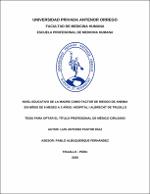Mostrar el registro sencillo del ítem
Nivel educativo de la madre como factor de riesgo de anemia en niños de 6 meses a 3 años. Hospital I Albrecht de Trujillo
| dc.contributor.advisor | Albuquerque Fernández, Pablo | |
| dc.contributor.author | Pastor Díaz, Luis Antonio | |
| dc.creator | Pastor Díaz, Luis Antonio | |
| dc.date.accessioned | 2020-02-25T15:01:46Z | |
| dc.date.available | 2020-02-25T15:01:46Z | |
| dc.date.issued | 2020 | |
| dc.identifier.uri | https://hdl.handle.net/20.500.12759/6012 | |
| dc.description.abstract | OBJETIVOS: Determinar si el nivel educativo de la madre es factor de riesgo de anemia en niños de 6 meses a 3 años. MATERIAL Y METODOS: Mediante un diseño prospectivo analítico seccional-transversal en 265 niños y sus madres, en dos grupos sin anemia (hemoglobina 11 gr/dl o >) y con anemia (<11 gr/dl de Hb), en los que comparó la presencia de anemia entre grupos con nivel educativo de la madre alto (199 educaciòn superior) y 66 bajo (niveles inferiores). RESULTADOS: Se estudiaron 265 niños y sus madres. La prevalencia de anemia en la poblaciòn de estudio fue de 19,24%. Los hijos de madres con NE alto tuvieron mayor nivel de hemoglobina (media 11.52 ± 0,989), que los que tuvieron NE bajo (10,81 ± 1,147). Existe significancia en la diferencia de medias p=0,000. La prevalencia de anemia en hijos de madre con NE bajo fue de 37.087 % y de 13.06 % en el NE alto. El NEM bajo es factor de riesgo de anemia en sus hijos con OR 2.623 (1,76-3,89) p=0,000. El OR ajustado a Lactancia Materna Exclusiva, sexo, edad y estado nutricional fue de 2,43 (1,25.4,71) p=0.00. CONCLUSIONES: El NEM bajo es factor de riesgo de desarrollar anemia en sus hijos de 6 a 36 meses de edad. | es_PE |
| dc.description.abstract | OBJECTIVES: To determine if the mother's educational level is a risk factor for anemia in children ages 6 months to 3 years. MATERIAL AND METHODS: Through a prospective analytical crosssectional in 265 children and their mothers, in two groups without anemia (hemoglobin 11 gr/dl o >) and with anemia (<11 gr/dl of Hb), in which he compared the presence of anemia between groups with educational level (199) upper and (66) low. RESULTS: The prevalence of anemia in the study population was 19.24%. The children of mothers with high educational levels had a higher level of haemoglobin (average 11.52 ± 0.989), than those who had low educational level (10.81 ± 1,147). There is significance in the difference of averages p0.000.The prevalence of anemia children of a mother with low ducational level was 37,087% and 13.06% at the high level. The low maternal education level is a risk factor for anemia in your children OR= 2.623 (CI 95% 1,76 - 3,89) p=0,000. OR. The OR adjusted for Exclusive Breastfeeding, sex, age and nutritional status was 2.43 (1,25.4,71) p.00. CONCLUSIONS: Low maternal education level is a risk factor for developing anemia in your children ages 6 to 36 months. | en_US |
| dc.description.uri | Tesis | es_PE |
| dc.format | application/pdf | es_PE |
| dc.language.iso | spa | es_PE |
| dc.publisher | Universidad Privada Antenor Orrego - UPAO | es_PE |
| dc.relation.ispartofseries | T_MED.HUMA_2703 | |
| dc.rights | info:eu-repo/semantics/openAccess | es_PE |
| dc.source | Universidad Privada Antenor Orrego | es_PE |
| dc.source | Repositorio Institucional - UPAO | es_PE |
| dc.subject | Nivel educativo | es_PE |
| dc.subject | Anemia | es_PE |
| dc.title | Nivel educativo de la madre como factor de riesgo de anemia en niños de 6 meses a 3 años. Hospital I Albrecht de Trujillo | es_PE |
| dc.type | info:eu-repo/semantics/bachelorThesis | es_PE |
| thesis.degree.level | Título Profesional | es_PE |
| thesis.degree.grantor | Universidad Privada Antenor Orrego. Facultad de Medicina Humana | es_PE |
| thesis.degree.name | Médico Cirujano | es_PE |
| thesis.degree.discipline | Medicina Humana | es_PE |
Ficheros en el ítem
Este ítem aparece en la(s) siguiente(s) colección(es)
-
Medicina Humana [2722]

